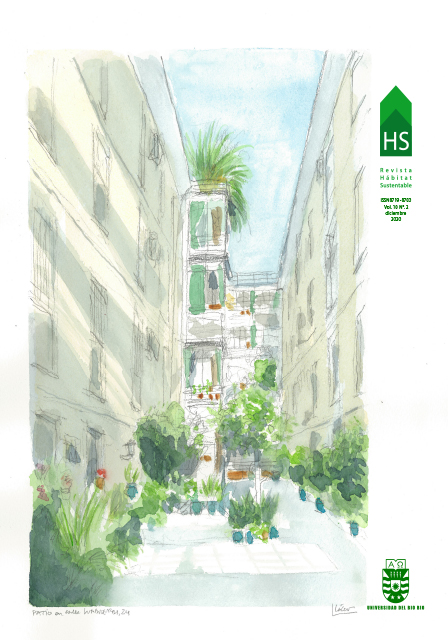Influencia en el rendimiento energético en edificios históricos provocado por el entorno urbano y las modificaciones de proyecto: el caso de la Casa Duclós
DOI:
https://doi.org/10.22320/07190700.2020.10.02.03Palavras-chave:
patrimonio arquitectónico, ahorro de energía, estrategias urbanas, arquitectura modernaResumo
Los edificios históricos constituyen parte fundamental del patrimonio cultural tangible de la sociedad actual. El cumplimiento de las exigencias de ahorro energético para mitigar el cambio climático, sin embargo, puede verse limitado aquí debido a las características propias de estos edificios. Además, en el caso de las construcciones históricas, los principios de diseño bioclimático aplicados por los arquitectos, desde principios del siglo XX hasta la actualidad, pueden haber perdido efectividad. Ello ocurre, a veces, por las modificaciones en proyecto o por efectos del desarrollo urbanístico. En este estudio se analizan estos dos aspectos en un determinado edificio histórico ubicado en Sevilla: la Casa Duclós de José Luis Sert. Este presenta modificaciones en la cubierta, cuando se compara la proyectada y la construida. Asimismo, su entorno urbano se ha transformado desde que la Casa fue edificada. Para el análisis expuesto en este artículo, se realizaron simulaciones energéticas utilizando datos climáticos correspondientes al periodo 2000-2019. Los resultados muestran la influencia que tuvieron las modificaciones de la cubierta proyectada y la expansión urbanística en el rendimiento energético del edificio, con respecto a la concepción original del inmueble.
Downloads
Referências
Akande, O. K., Odeleye, D., Coday, A. y JimenezBescos, C. (2016). Performance evaluation of operational energy use in refurbishment, reuse, and conservation of heritage buildings for optimum sustainability. Frontiers of Architectural Research, 5(3), 371–382. DOI: https://doi.org/10.1016/j.foar.2016.06.002
Baño Nieva, A. y Vigil-Escalera del Pozo, A. (2005). Guía de construcción sostenible. Madrid: Ministerio de Medio Ambiente.
Beltrán-Fernández, M., García-Muñoz, J. y Dufrasnes, E. (2017). Análisis de las estrategias bioclimáticas empleadas por Frank Lloyd Wright en la Casa Jacobs I. Informes de la Construccion, 69(547). DOI: https://doi.org/10.3989/ic.16.156
Bono Ruiz de la Herrán, L., García Vásquez, C., Pérez Escolano, V., Pico Valimaña, R. y Ortega, C. (1996). Veinte obras del Movimiento Moderno en Andalucía. Boletín Del Instituto Andaluz del Patrimonio Histórico, 15, 133-152.
De Rubeis, T., Nardi, I., Muttillo, M. y Paoletti, D. (2019). The restoration of severely damaged churches – Implications and opportunities on cultural heritage conservation, thermal comfort and energy efficiency. Journal of Cultural Heritage, 43, 186–203. DOI: https://doi.org/10.1016/j.culher.2019.11.008
Delgado Pérez, G., Pérez Escolano, V., Sebastián Bollaín, J. y Ramón Sierra, J. (1968). La obra olvidada: Casa Duclós en Sevilla, 1930. Hogar y Arquitectura, 76, 57–64.
Ficco, G., Iannetta, F., Ianniello, E., D’Ambrosio Alfano, F. R. y Dell’Isola, M. (2015). U-value in situ measurement for energy diagnosis of existing buildings. Energy and Buildings, 104, 108–121. DOI: https://doi.org/10.1016/j.enbuild.2015.06.071
Iommi, M. (2019). Daylighting performances and visual comfort in Le Corbusier’s architecture. The daylighting analysis of seven unrealized residential buildings. Energy and Buildings, 184, 242–263. DOI: https://doi.org/10.1016/j.enbuild.2018.12.014
Lidelöw, S., Örn, T., Luciani, A. y Rizzo, A. (2019). Energy-efficiency measures for heritage buildings: A literature review. Sustainable Cities and Society, 45(June), 231–242. DOI: https://doi.org/10.1016/j.scs.2018.09.029
Lobaccaro, G., Croce, S., Lindkvist, C., Munari Probst, M. C., Scognamiglio, A., Dahlberg, J., Lundgren, M. y Wall, M. (2019). A cross-country perspective on solar energy in urban planning: Lessons learned from international case studies. Renewable and Sustainable Energy Reviews, 108(March), 209–237. DOI: https://doi.org/10.1016/j.rser.2019.03.041
López Rivera, F. J. y Parra Bañón, J. J. (2012). El proyecto de construcción de la imagen de la arquitectura moderna 1925-1939 Andalucía, Margaret Michaelis. Universidad de Sevila. Recuperado de http://fama.us.es/record=b2497190~S5*spi
Lousame, M. (2011). La Casa Duclós de José Luis Sert en Sevilla en 1930. Dibujo y construcción. Dibujo y construcción. En Actas del Séptimo Congreso Nacional de Historia de la Construcción: Santiago de Compostela, 26-29 octubre de 2011 (pp. 799-808). Instituto Juan de Herrera.
Olona, J. (2015). Avaluació de l’envolupant dels edificis del moviment modern a Barcelona. Subirana i Casa Bloc : recerques i influències dels paradigmes d’una nova materialitat energètica. Universitat Politècnica de Catalunya.
Paricio Casademunt, A. (1996). La innovación tecnológica de las cubiertas planas del GATCPAC. Actas del Primer Congreso Nacional de Historia de la Construcción (Madrid 19–21 septiembre) (pp. 419-422). Recuperado de http://www.sedhc.es/biblioteca/actas/CNHC1_058.pdf
Paricio Casademunt, A. (1998). La cámara ventilada como recurso constructivo durante el siglo XIX en Barcelona. En II Congreso Nacional de Historia de la Construcción (pp. 375–380). Recuperado de https://ruc.udc.es/dspace/bitstream/handle/2183/10595/HC%2048.pdf?sequence=1&isAllowed=y
Quesada, S. (2008). Helion, Melion, Tetragrámmaton. La Casa Duclòs. Sevilla, España, 1929-1930. En Cohen, M., Seven Avant-Garde Houses (pp. 192-219). Bruselas: CIVA.
Sert, J. L., Vázquez de Castro, A. e Íñiguez de Onzoño, J. L. (2009). Edificio de viviendas en calle de Muntaner, Barcelona 1929-31. GIVCO Collective Housing Research Group, Universidad Politécnica de Madrid. Recuperado de http://fama.us.es/record=b2148137~S5*spi
Sugár, V., Talamon, A., Horkai, A. y Kita, M. (2020). Energy saving retrofit in a heritage district: The case of the Budapest. Journal of Building Engineering, 27, 1–20. DOI: https://doi.org/10.1016/j.jobe.2019.100982
Downloads
Publicado
Como Citar
Edição
Secção
Licença
Direitos de Autor (c) 2020 Isidro Cortés, David Bienvenido-Huertas

Este trabalho encontra-se publicado com a Licença Internacional Creative Commons Atribuição-CompartilhaIgual 4.0.
O conteúdo dos artigos publicados em cada número do Habitat Sustentável é da exclusiva responsabilidade dos autores e não representa necessariamente o pensamento ou compromete a opinião da Universidad del Bío-Bío.
Os autores mantêm os seus direitos de autor e concedem à revista o direito de primeira publicação da sua obra, que está simultaneamente sujeita à Licença de Atribuição Creative Commons CC BY-SA que permite a outros partilhar, transformar ou criar novo material a partir desta obra para fins não comerciais, desde que a autoria e a primeira publicação nesta revista sejam reconhecidas, e as suas novas criações sejam licenciadas sob os mesmos termos.











 Programa de Informação Científica/Concurso Fondos de Publicación de Revistas Científicas 2018/ Proyecto Mejoramiento de Visibilidad de Revistas UBB (Código:FP180007)
Programa de Informação Científica/Concurso Fondos de Publicación de Revistas Científicas 2018/ Proyecto Mejoramiento de Visibilidad de Revistas UBB (Código:FP180007)





